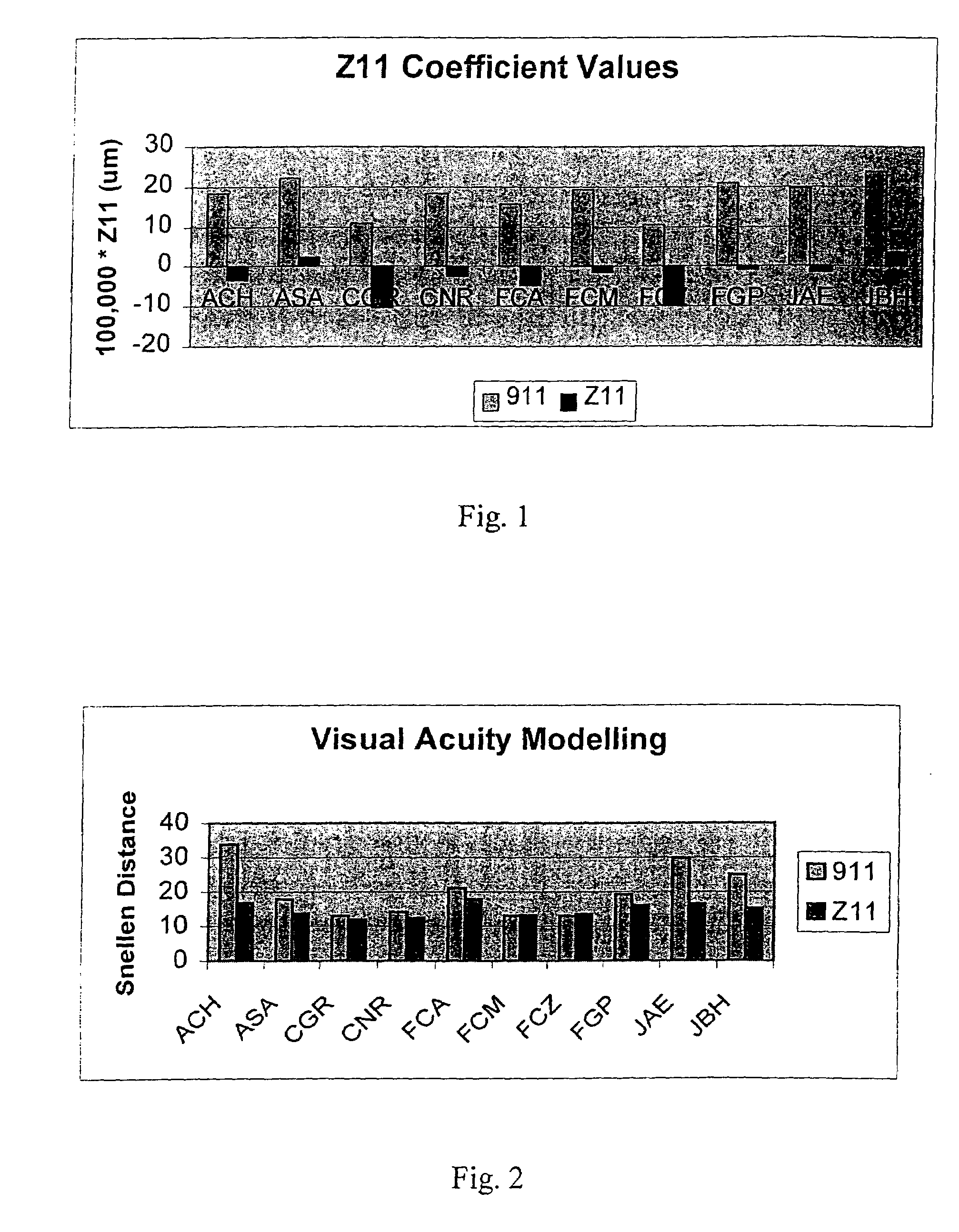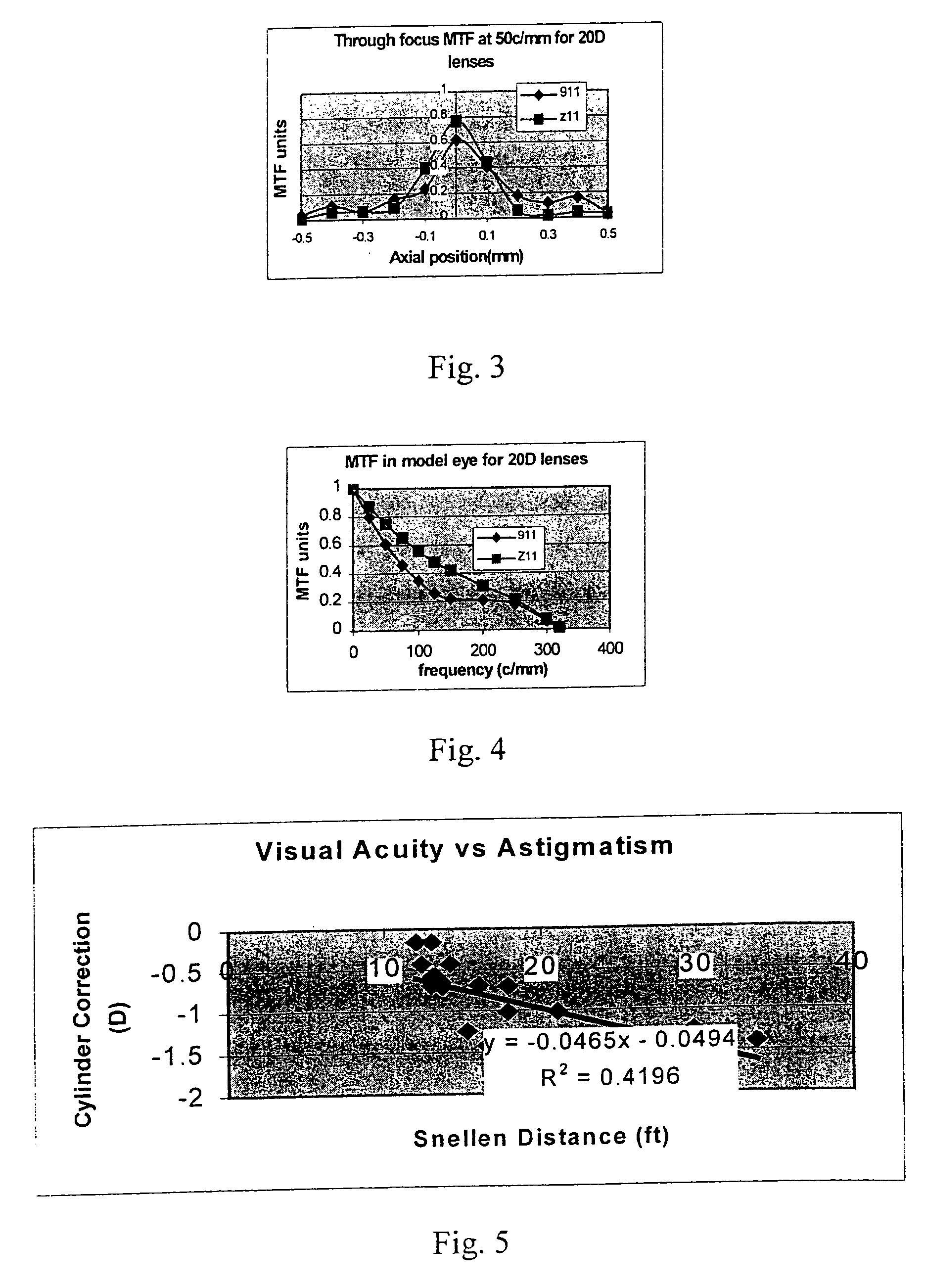Methods of obtaining ophthalmic lenses providing the eye with reduced aberrations
a technology of ophthalmic lenses and aberrations, applied in optics, medical science, instruments, etc., can solve the problems of age-related aberration, inability to adapt ophthalmic lenses, and failure to correct for a number of aberration phenomena of the ey
- Summary
- Abstract
- Description
- Claims
- Application Information
AI Technical Summary
Benefits of technology
Problems solved by technology
Method used
Image
Examples
example 1
[0063]A sample set of 10 corneal surfaces from individuals were described using Zernike polynomials. The sag data of the corneas was determined using the real height data measured with a Humphrey Atlas corneal topographer. The corneal topographer measures the height (zi) at a discrete number of points. The corneal surface can then be expressed as a linear combination of the first 15 Zernike polynomials (as described in Equation 1, above), where Zi is the ith Zernike polynomial and ai is the weighting coefficient for this polynomial. The Zernike polynomials are a set of complete orthogonal polynomials defined on a unit circle. These polynomials as listed in Table 1 above and the weighting coefficients (ai) are calculated from the height data using a Grahm-Schmidt orthogonalization procedure. The Zernike coefficients (ai) for the 10 sample corneas are listed in Table 2 in mm.
[0064]
TABLE 2The Zernike coefficients for the 10 individual corneal surfaces in mm.ACHASACGRCNRFCAFCMFCZFGPJAEJ...
example 2
[0067]An averaged design embodiment of the inventive lenses has been calculated using the average “old” cornea information provided by Pablo Artal, Murcia, Spain. This data was taken from a population sample of 16 old corneas in which all of the subjects had a visual acuity of 20 / 30 or better. The corneal surfaces were described using Zernike polynomials for an aperture of 2.0 mm radius (ro). The polynomial coefficients were then used to determine the radius and asphericity values using Equations 2 and 3.
[0068]R=ro22(23a4-65a11)(2)K2=8R3ro465a11(3)
[0069]Note that the asphericity constant, K, describes the surface's variation from a sphere (K2=1−e2). (i.e. For a sphere K=1 and for a parabola K=0). (cc=K2−1, wherein cc is the conical constant)
[0070]Because the cornea surface has only been described for a central diameter of 4 mm, the calculated R and K are also only accurate over the central 4 mm. A pupil size of 4.0 mm is therefore selected for design purposes. This pupil ...
example 3
Individually Designed Lenses:
[0080]As a potential further improvement upon the averaged lens (“Z11 lenses”), an individualized lens (“I11 lenses”) was designed for each of four subject corneas employing the same design principles as demonstrated in Example 2. The individual lenses were designed such that the Z11 of the lens balances the Z11 of the individual cornea. The total-eye Z11 coefficients for the I11 lenses are shown in Table 7, together
[0081]
TABLE 7The Z11 coefficients in mm of the model eyeswith the 911, Z11 and I11 lensesSubject911averagedindividualCGR0.000107−0.000101−0.000004FCZ0.000105−0.000100−0.000005JAE0.000195−0.000016−0.000012JBH0.0002380.000037−0.000019
with the corresponding coefficients for the 911 and the averaged lenses. Furthermore, for each of the 911, Z11 (averaged), and I11 (individual) lenses, the MTF curve at best focussed at 50 c / mm and the through focus MTF at 50 c / mm for subject JAE are plotted below in FIGS. 7 and 8. From FIGS. 7 and 8, it is seen th...
PUM
 Login to View More
Login to View More Abstract
Description
Claims
Application Information
 Login to View More
Login to View More - R&D
- Intellectual Property
- Life Sciences
- Materials
- Tech Scout
- Unparalleled Data Quality
- Higher Quality Content
- 60% Fewer Hallucinations
Browse by: Latest US Patents, China's latest patents, Technical Efficacy Thesaurus, Application Domain, Technology Topic, Popular Technical Reports.
© 2025 PatSnap. All rights reserved.Legal|Privacy policy|Modern Slavery Act Transparency Statement|Sitemap|About US| Contact US: help@patsnap.com



